Pre-Ball-Milled Boron Nitride for the Preparation of Boron Nitride/Polyetherimide Nanocomposite Film with Enhanced Breakdown Strength and Mechanical Properties for Thermal Management
Abstract
1. Introduction
2. Materials and Methods
2.1. Materials
2.2. Preparation of Sugar-Assisted Ball-Milled BN Powder
2.3. Preparation of PEI Composite Films
2.4. Characterization
3. Results and Discussion
3.1. Thermal Properties Analysis
3.2. Application Assurance
3.3. Morphological Distribution
3.4. Thermal Management
4. Conclusions
Author Contributions
Funding
Institutional Review Board Statement
Informed Consent Statement
Data Availability Statement
Acknowledgments
Conflicts of Interest
References
- Zhang, X.-D.; Yang, X.-H.; Zhou, Y.-X.; Rao, W.; Gao, J.-Y.; Ding, Y.-J.; Shu, Q.-Q.; Liu, J. Experimental investigation of galinstan based minichannel cooling for high heat flux and large heat power thermal management. Energy Convers. Manag. 2019, 185, 248–258. [Google Scholar] [CrossRef]
- Lee, D.; Lee, H.; Song, T.; Paik, U. Toward High Rate Performance Solid–State Batteries. Adv. Energy Mater. 2022, 12, 2200948. [Google Scholar] [CrossRef]
- Li, R.; Yang, X.; Li, J.; Shen, Y.; Zhang, L.; Lu, R.; Wang, C.; Zheng, X.; Chen, H.; Zhang, T. Review on polymer composites with high thermal conductivity and low dielectric properties for electronic packaging. Mater. Today Phys. 2022, 22, 100594. [Google Scholar] [CrossRef]
- Xing, L.; Luscombe, C.K. Advances in applying C–H functionalization and naturally sourced building blocks in organic semiconductor synthesis. J. Mater. Chem. C 2021, 9, 16391–16409. [Google Scholar] [CrossRef]
- Xiang, J.; Zhou, G.; Hong, Y.; He, W.; Wang, S.; Chen, Y.; Wang, C.; Tang, Y.; Sun, Y.; Zhu, Y. Direct additive copper plating on polyimide surface with silver ammonia via plasma modification. Appl. Surf. Sci. 2022, 587, 152848. [Google Scholar] [CrossRef]
- Wang, B.; Wang, L.; Mu, W.; Qin, M.; Yang, F.; Liu, J.; Tomoyuki, Y.; Tatsuhiko, F. Thermal Performances and Annual Damages Comparison of MMC Using Reverse Conducting IGBT and Conventional IGBT Module. IEEE Trans. Power Electron. 2021, 36, 9806–9825. [Google Scholar] [CrossRef]
- Wu, X.; Li, H.; Cheng, K.; Qiu, H.; Yang, J. Modified graphene/polyimide composite films with strongly enhanced thermal conductivity. Nanoscale 2019, 11, 8219–8225. [Google Scholar] [CrossRef]
- Kim, K.; Kim, J. Exfoliated boron nitride nanosheet/MWCNT hybrid composite for thermal conductive material via epoxy wetting. Compos. Part B Eng. 2018, 140, 9–15. [Google Scholar] [CrossRef]
- Wu, L.; Luo, N.; Xie, Z.; Liu, Y.; Chen, F.; Fu, Q. Improved breakdown strength of Poly(vinylidene fluoride)-based composites by using all ball-milled hexagonal boron nitride sheets without centrifugation. Compos. Sci. Technol. 2020, 190, 108046. [Google Scholar] [CrossRef]
- Guo, Y.; Ruan, K.; Shi, X.; Yang, X.; Gu, J. Factors affecting thermal conductivities of the polymers and polymer composites: A review. Compos. Sci. Technol. 2020, 193, 108134. [Google Scholar] [CrossRef]
- Wu, M.; Yang, L.; Zhou, Y.; Jiang, J.; Zhang, L.; Rao, T.; Yang, P.; Liu, B.; Liao, W. BaTiO3-assisted exfoliation of boron nitride nanosheets for high-temperature energy storage dielectrics and thermal management. Chem. Eng. J. 2022, 427, 131860. [Google Scholar] [CrossRef]
- Ren, L.; Zeng, X.; Sun, R.; Xu, J.-B.; Wong, C.-P. Spray-assisted assembled spherical boron nitride as fillers for polymers with enhanced thermally conductivity. Chem. Eng. J. 2019, 370, 166–175. [Google Scholar] [CrossRef]
- Xie, Z.; Wu, K.; Liu, D.; Zhang, Q.; Fu, Q. One-step alkyl-modification on boron nitride nanosheets for polypropylene nanocomposites with enhanced thermal conductivity and ultra-low dielectric loss. Compos. Sci. Technol. 2021, 208, 108756. [Google Scholar] [CrossRef]
- Guerra, V.; Wan, C.; McNally, T. Thermal conductivity of 2D nano-structured boron nitride (BN) and its composites with polymers. Prog. Mater. Sci. 2019, 100, 170–186. [Google Scholar] [CrossRef]
- Bai, X.; Zhang, C.; Zeng, X.; Ren, L.; Sun, R.; Xu, J. Recent progress in thermally conductive polymer/boron nitride composites by constructing three-dimensional networks. Compos. Commun. 2021, 24, 100650. [Google Scholar] [CrossRef]
- Ayoob, R.; Alhabill, F.; Andritsch, T.; Vaughan, A. Enhanced dielectric properties of polyethylene/hexagonal boron nitride nanocomposites. J. Mater. Sci. 2017, 53, 3427–3442. [Google Scholar] [CrossRef]
- Song, Q.; Zhu, W.; Deng, Y.; Zhu, M.; Zhang, Q. Synergetic optimization of thermal conductivity and breakdown strength of boron nitride/poly (vinylidene fluoride) composite film with sandwich intercalated structure for heat management in flexible electronics. Compos. Part A Appl. Sci. Manuf. 2020, 135, 105933. [Google Scholar] [CrossRef]
- Han, G.; Zhao, X.; Feng, Y.; Ma, J.; Zhou, K.; Shi, Y.; Liu, C.; Xie, X. Highly flame-retardant epoxy-based thermal conductive composites with functionalized boron nitride nanosheets exfoliated by one-step ball milling. Chem. Eng. J. 2021, 407, 127099. [Google Scholar] [CrossRef]
- Zhang, Y.; Fan, Y.; Kamran, U.; Park, S.-J. Improved thermal conductivity and mechanical property of mercapto group-activated boron nitride/elastomer composites for thermal management. Compos. Part A Appl. Sci. Manuf. 2022, 156, 106869. [Google Scholar] [CrossRef]
- Yu, J.; Mo, H.; Jiang, P. Polymer/boron nitride nanosheet composite with high thermal conductivity and sufficient dielectric strength. Polym. Adv. Technol. 2015, 26, 514–520. [Google Scholar] [CrossRef]
- Pan, C.; Zhang, J.; Kou, K.; Zhang, Y.; Wu, G. Investigation of the through-plane thermal conductivity of polymer composites with in-plane oriented hexagonal boron nitride. Int. J. Heat Mass Transf. 2018, 120, 1–8. [Google Scholar] [CrossRef]
- Yung, K.C.; Liem, H. Enhanced thermal conductivity of boron nitride epoxy-matrix composite through multi-modal particle size mixing. J. Appl. Polym. Sci. 2007, 106, 3587–3591. [Google Scholar] [CrossRef]
- Ishida, H.; Rimdusit, S. Very high thermal conductivity obtained by boron nitride-filled polybenzoxazine. Thermochim. Acta 1998, 320, 177–186. [Google Scholar] [CrossRef]
- Gu, J.; Guo, Y.; Yang, X.; Liang, C.; Geng, W.; Tang, L.; Li, N.; Zhang, Q. Synergistic improvement of thermal conductivities of polyphenylene sulfide composites filled with boron nitride hybrid fillers. Compos. Part A Appl. Sci. Manuf. 2017, 95, 267–273. [Google Scholar] [CrossRef]
- Sato, K.; Horibe, H.; Shirai, T.; Hotta, Y.; Nakano, H.; Nagai, H.; Mitsuishi, K.; Watari, K. Thermally conductive composite films of hexagonal boron nitride and polyimide with affinity-enhanced interfaces. J. Mater. Chem. 2010, 20, 2749–2752. [Google Scholar] [CrossRef]
- Pan, C.; Kou, K.; Jia, Q.; Zhang, Y.; Wu, G.; Ji, T. Improved thermal conductivity and dielectric properties of hBN/PTFE composites via surface treatment by silane coupling agent. Compos. Part B Eng. 2017, 111, 83–90. [Google Scholar] [CrossRef]
- Zhou, S.; Xu, T.; Jiang, F.; Song, N.; Shi, L.; Ding, P. High thermal conductivity property of polyamide-imide/boron nitride composite films by doping boron nitride quantum dots. J. Mater. Chem. C 2019, 7, 13896–13903. [Google Scholar] [CrossRef]
- Korycki, A.; Chabert, F.; Merian, T.; Nassiet, V. Probing Wettability Alteration of the Boron Nitride Surface through Rheometry. Langmuir 2019, 35, 128–140. [Google Scholar] [CrossRef]
- Agrawal, A.; Chandrakar, S. Influence of particulate surface treatment on physical, mechanical, thermal, and dielectric behavior of epoxy/hexagonal boron nitride composites. Polym. Compos. 2020, 41, 1574–1583. [Google Scholar] [CrossRef]
- Chen, S.; Xu, R.; Liu, J.; Zou, X.; Qiu, L.; Kang, F.; Liu, B.; Cheng, H.M. Simultaneous Production and Functionalization of Boron Nitride Nanosheets by Sugar-Assisted Mechanochemical Exfoliation. Adv Mater 2019, 31, e1804810. [Google Scholar] [CrossRef]
- Balasubramanyan, S.; Sasidharan, S.; Poovathinthodiyil, R.; Ramakrishnan, R.M.; Narayanan, B.N. Sucrose-mediated mechanical exfoliation of graphite: A green method for the large scale production of graphene and its application in catalytic reduction of 4-nitrophenol. New J. Chem. 2017, 41, 11969–11978. [Google Scholar] [CrossRef]
- Ding, D.; Shang, Z.; Zhang, X.; Lei, X.; Liu, Z.; Zhang, Q.; Chen, Y. Greatly enhanced thermal conductivity of polyimide composites by polydopamine modification and the 2D-aligned structure. Ceram. Int. 2020, 46, 28363–28372. [Google Scholar] [CrossRef]
- Boukheit, A.; Chabert, F.; Otazaghine, B.; Taguet, A. h-BN Modification Using Several Hydroxylation and Grafting Methods and Their Incorporation into a PMMA/PA6 Polymer Blend. Nanomaterials 2022, 12, 2735. [Google Scholar] [CrossRef] [PubMed]
- Ge, M.; Zhang, J.; Zhao, C.; Lu, C.; Du, G. Effect of hexagonal boron nitride on the thermal and dielectric properties of polyphenylene ether resin for high-frequency copper clad laminates. Mater. Des. 2019, 182, 108028. [Google Scholar] [CrossRef]
- Wang, Z.-G.; Wei, X.; Bai, M.-H.; Lei, J.; Xu, L.; Huang, H.-D.; Du, J.; Dai, K.; Xu, J.-Z.; Li, Z.-M. Green Production of Covalently Functionalized Boron Nitride Nanosheets via Saccharide-Assisted Mechanochemical Exfoliation. ACS Sustain. Chem. Eng. 2021, 9, 11155–11162. [Google Scholar] [CrossRef]
- Li, Y.; Huang, T.; Chen, M.; Wu, L. Simultaneous exfoliation and functionalization of large-sized boron nitride nanosheets for enhanced thermal conductivity of polymer composite film. Chem. Eng. J. 2022, 442, 136237. [Google Scholar] [CrossRef]
- Ramos, K.J.; Bahr, D.F. Mechanical behavior assessment of sucrose using nanoindentation. J. Mater. Res. 2011, 22, 2037–2045. [Google Scholar] [CrossRef]
- Lei, W.; Mochalin, V.N.; Liu, D.; Qin, S.; Gogotsi, Y.; Chen, Y. Boron nitride colloidal solutions, ultralight aerogels and freestanding membranes through one-step exfoliation and functionalization. Nat. Commun. 2015, 6, 8849. [Google Scholar] [CrossRef]
- Tanimoto, M.; Yamagata, T.; Miyata, K.; Ando, S. Anisotropic thermal diffusivity of hexagonal boron nitride-filled polyimide films: Effects of filler particle size, aggregation, orientation, and polymer chain rigidity. ACS Appl. Mater. Interfaces 2013, 5, 4374–4382. [Google Scholar] [CrossRef]
- Bozkurt, Y.E.; Yıldız, A.; Türkarslan, Ö.; Şaşal, F.N.; Cebeci, H. Thermally conductive h-BN reinforced PEI composites: The role of processing conditions on dispersion states. Mater. Today Commun. 2021, 29, 102854. [Google Scholar] [CrossRef]
- Gu, J.; Lv, Z.; Wu, Y.; Guo, Y.; Tian, L.; Qiu, H.; Li, W.; Zhang, Q. Dielectric thermally conductive boron nitride/polyimide composites with outstanding thermal stabilities via in -situ polymerization-electrospinning-hot press method. Compos. Part A Appl. Sci. Manuf. 2017, 94, 209–216. [Google Scholar] [CrossRef]
- Madakbaş, S.; Çakmakçı, E.; Kahraman, M.V. Preparation and thermal properties of polyacrylonitrile/hexagonal boron nitride composites. Thermochim. Acta 2013, 552, 1–4. [Google Scholar] [CrossRef]
- Zhuo, L.; Chen, S.; Xie, F.; Qin, P.; Lu, Z. Toward high thermal conductive aramid nanofiber papers: Incorporating hexagonal boron nitride bridged by silver nanoparticles. Polym. Compos. 2021, 42, 1773–1781. [Google Scholar] [CrossRef]
- Peng, X.; Liu, X.; Qu, P.; Yang, B. Enhanced breakdown strength and energy density of PVDF composites by introducing boron nitride nanosheets. J. Mater. Sci. Mater. Electron. 2018, 29, 16799–16804. [Google Scholar] [CrossRef]
- Luo, W.; Zeng, J.; Chen, Y.; Dai, W.; Yao, Y.; Luo, B.; Zhang, F.; Wang, T. Surface modification of h-BN and preparation of h-BN/PEI thermally conductive flexible films. Polym. Compos. 2022, 43, 3846–3857. [Google Scholar] [CrossRef]
- Liu, X.; Ji, T.; Li, N.; Liu, Y.; Yin, J.; Su, B.; Zhao, J.; Li, Y.; Mo, G.; Wu, Z. Preparation of polyimide composites reinforced with oxygen doped boron nitride nano-sheet as multifunctional materials. Mater. Des. 2019, 180, 107963. [Google Scholar] [CrossRef]
- Zhang, T.; Sun, J.; Ren, L.; Yao, Y.; Wang, M.; Zeng, X.; Sun, R.; Xu, J.-B.; Wong, C.-P. Nacre-inspired polymer composites with high thermal conductivity and enhanced mechanical strength. Compos. Part A Appl. Sci. Manuf. 2019, 121, 92–99. [Google Scholar] [CrossRef]
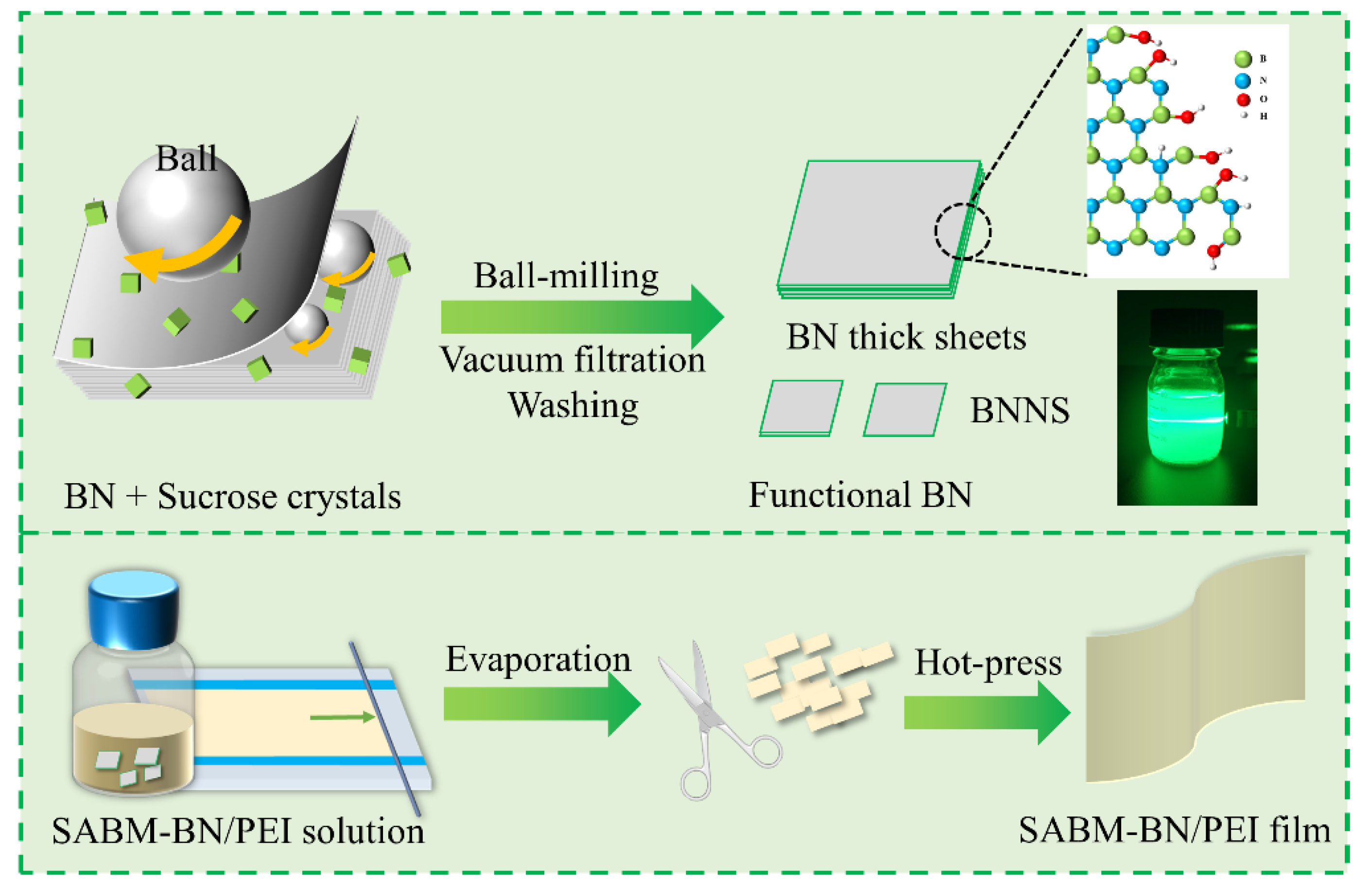
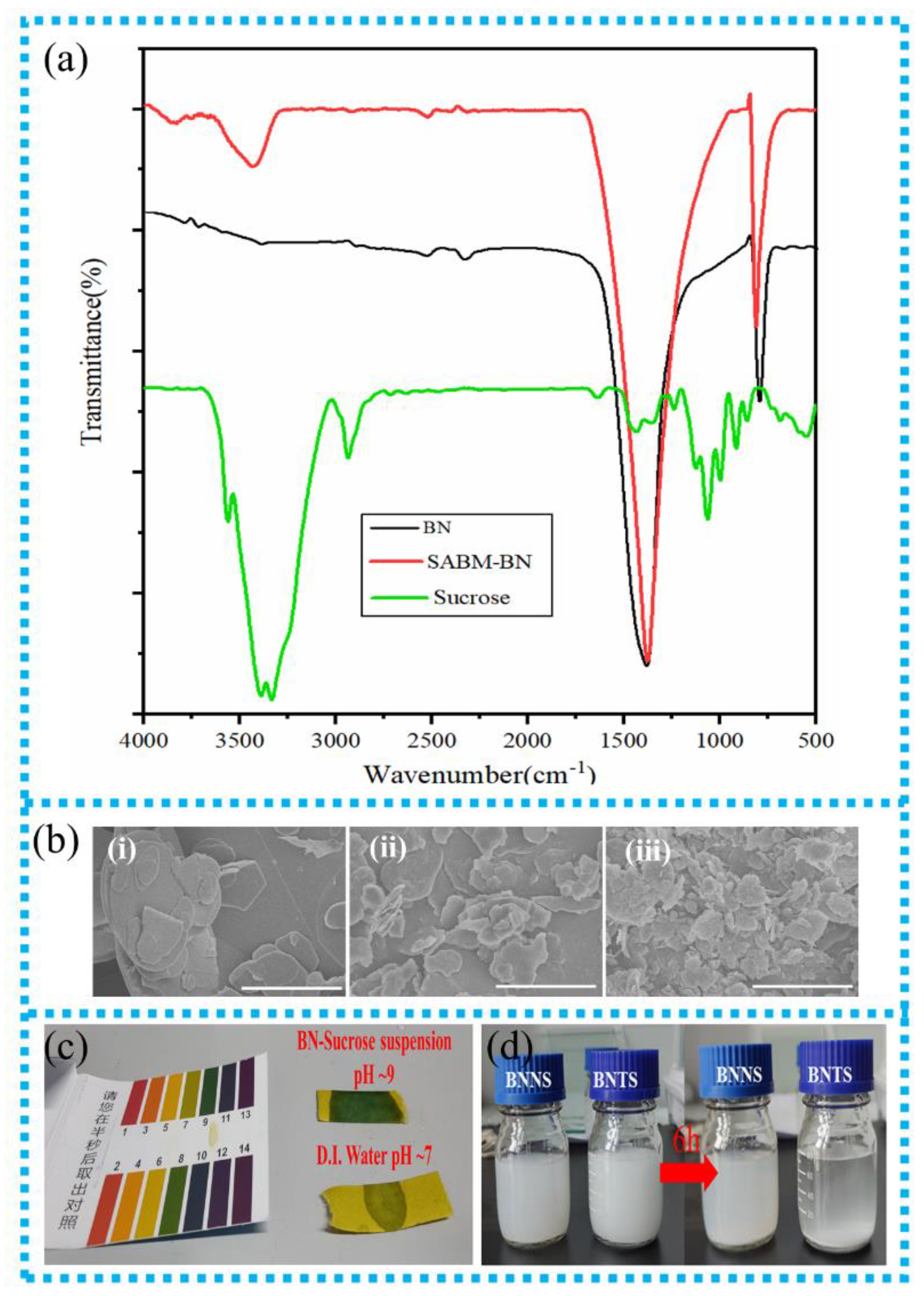
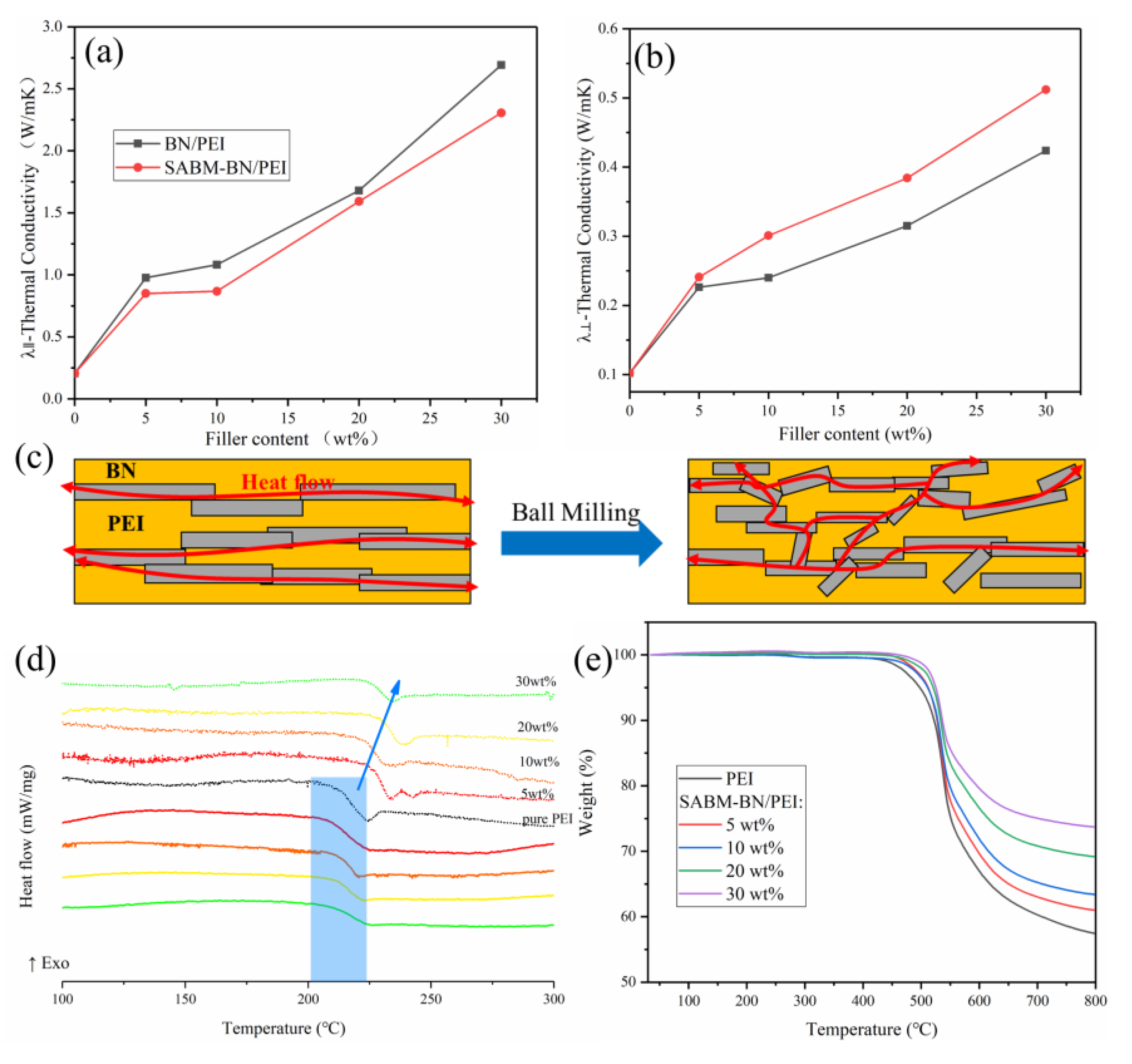
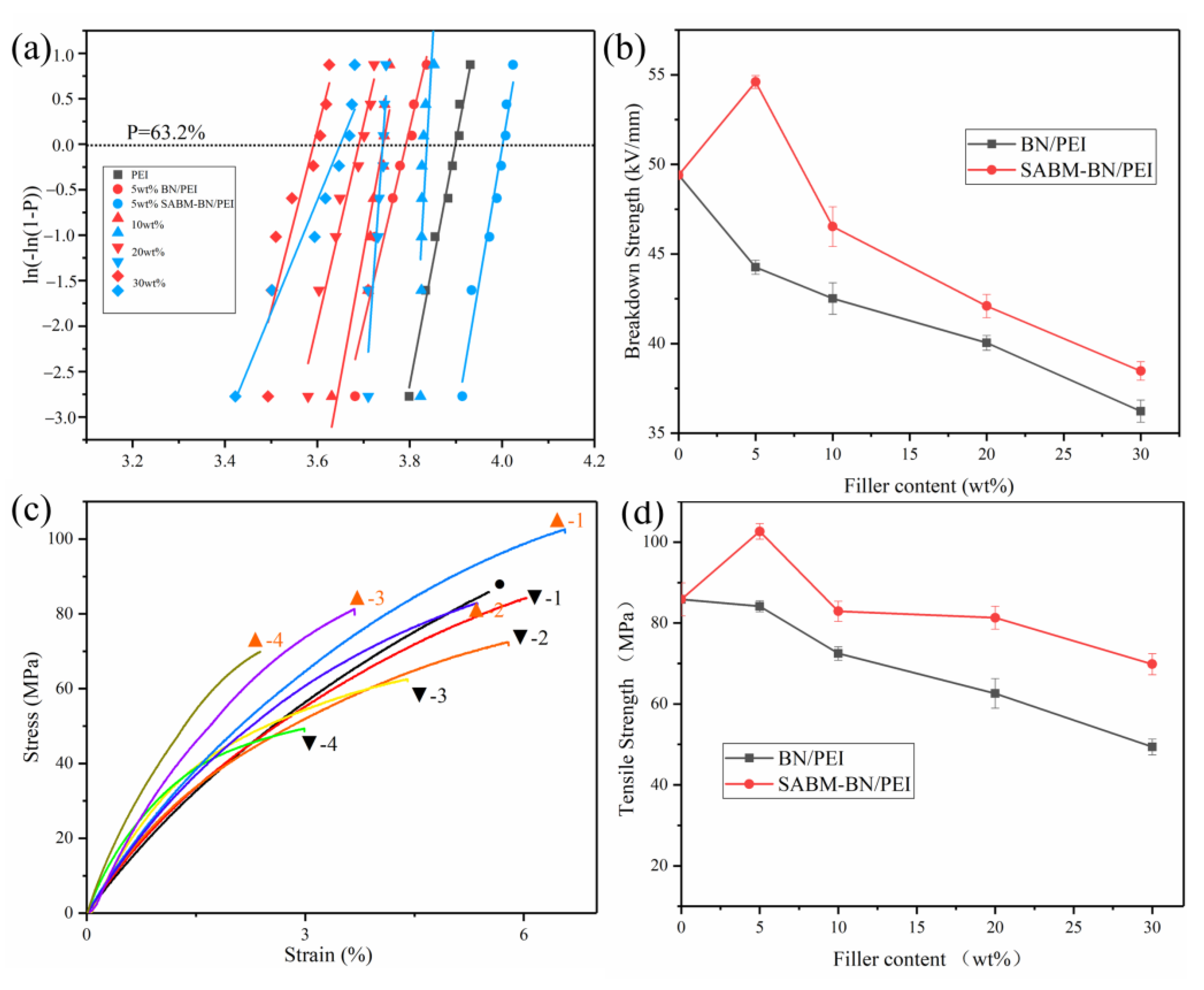
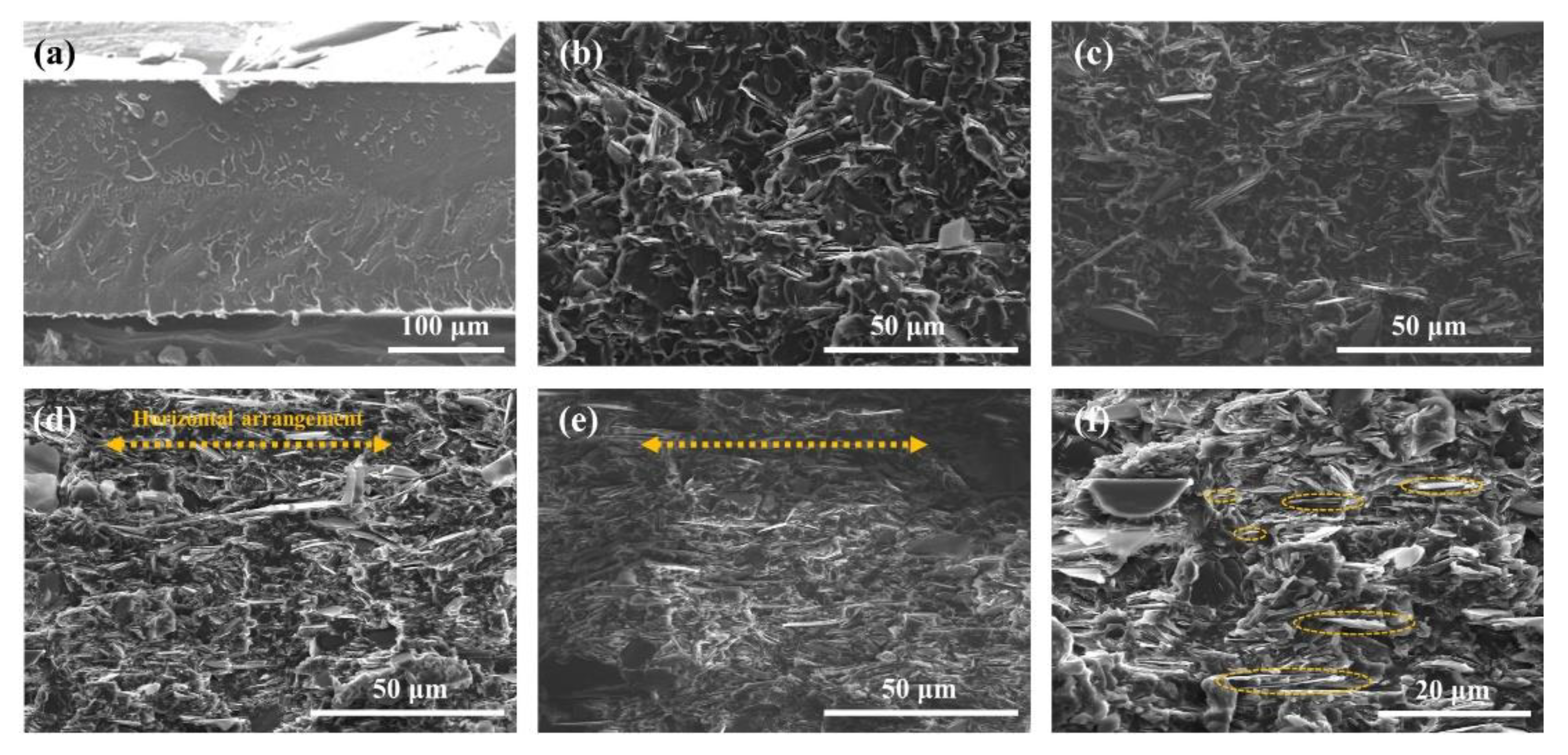
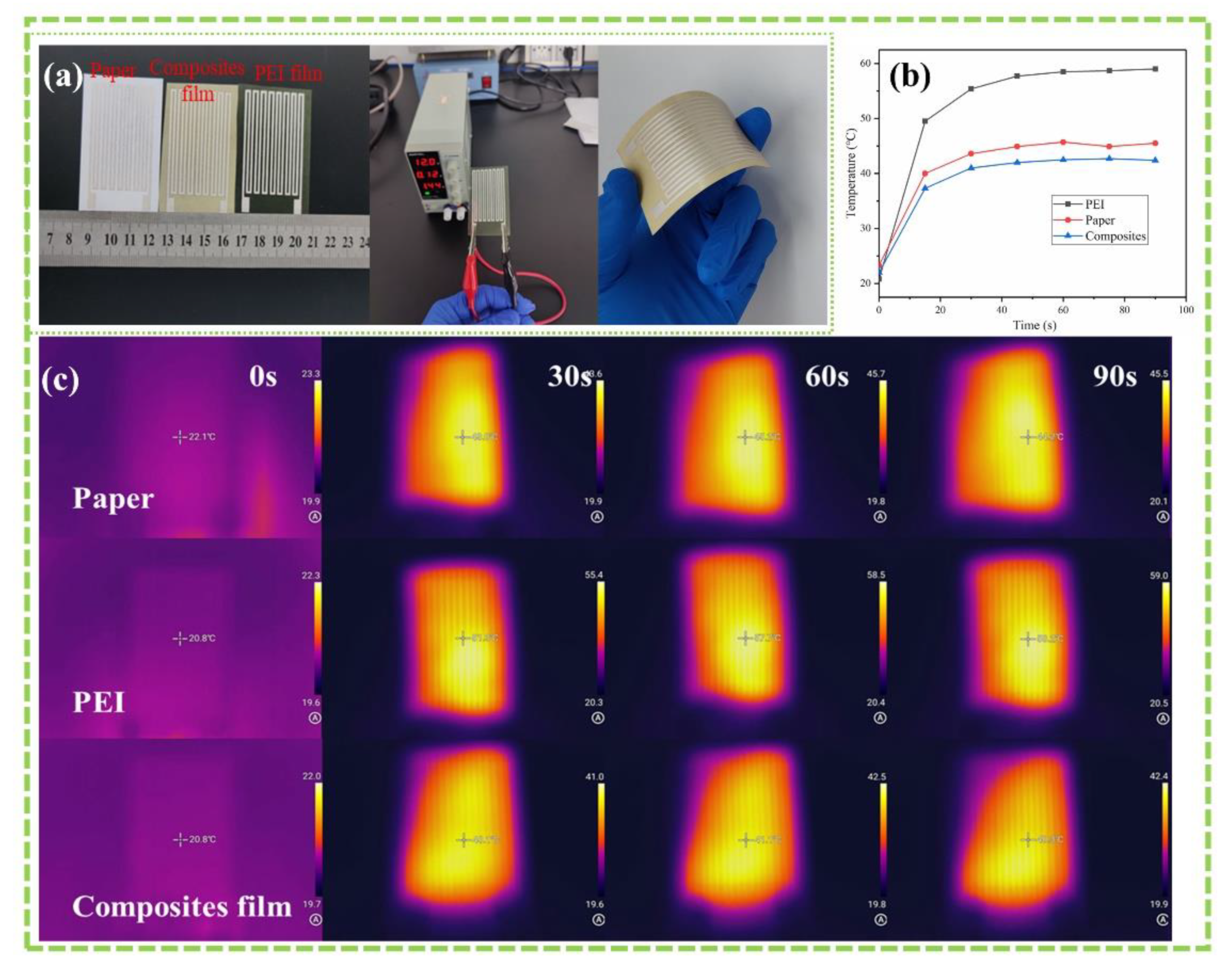
Publisher’s Note: MDPI stays neutral with regard to jurisdictional claims in published maps and institutional affiliations. |
© 2022 by the authors. Licensee MDPI, Basel, Switzerland. This article is an open access article distributed under the terms and conditions of the Creative Commons Attribution (CC BY) license (https://creativecommons.org/licenses/by/4.0/).
Share and Cite
Li, R.; Yang, X.; Li, J.; Liu, D.; Zhang, L.; Chen, H.; Zheng, X.; Zhang, T. Pre-Ball-Milled Boron Nitride for the Preparation of Boron Nitride/Polyetherimide Nanocomposite Film with Enhanced Breakdown Strength and Mechanical Properties for Thermal Management. Nanomaterials 2022, 12, 3473. https://doi.org/10.3390/nano12193473
Li R, Yang X, Li J, Liu D, Zhang L, Chen H, Zheng X, Zhang T. Pre-Ball-Milled Boron Nitride for the Preparation of Boron Nitride/Polyetherimide Nanocomposite Film with Enhanced Breakdown Strength and Mechanical Properties for Thermal Management. Nanomaterials. 2022; 12(19):3473. https://doi.org/10.3390/nano12193473
Chicago/Turabian StyleLi, Ruiyi, Xiao Yang, Jian Li, Ding Liu, Lixin Zhang, Haisheng Chen, Xinghua Zheng, and Ting Zhang. 2022. "Pre-Ball-Milled Boron Nitride for the Preparation of Boron Nitride/Polyetherimide Nanocomposite Film with Enhanced Breakdown Strength and Mechanical Properties for Thermal Management" Nanomaterials 12, no. 19: 3473. https://doi.org/10.3390/nano12193473
APA StyleLi, R., Yang, X., Li, J., Liu, D., Zhang, L., Chen, H., Zheng, X., & Zhang, T. (2022). Pre-Ball-Milled Boron Nitride for the Preparation of Boron Nitride/Polyetherimide Nanocomposite Film with Enhanced Breakdown Strength and Mechanical Properties for Thermal Management. Nanomaterials, 12(19), 3473. https://doi.org/10.3390/nano12193473





